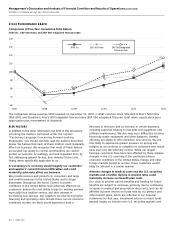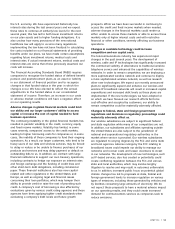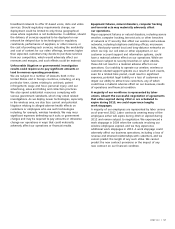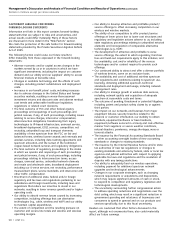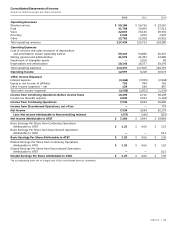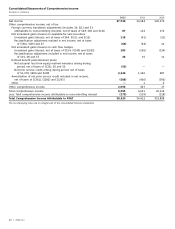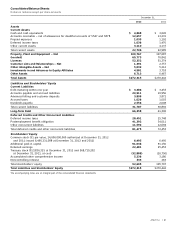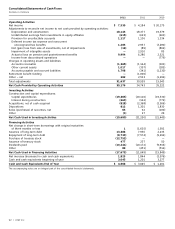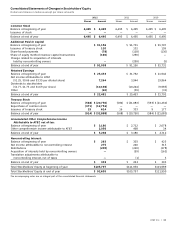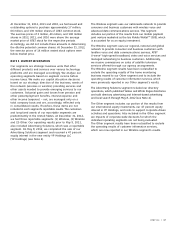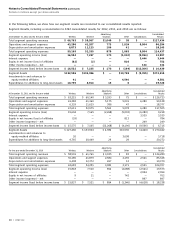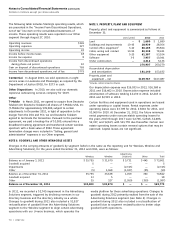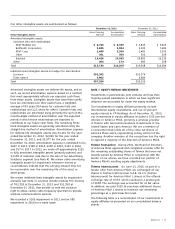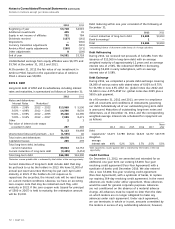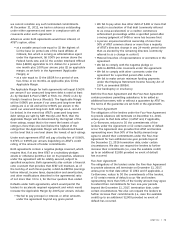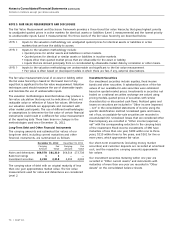AT&T Wireless 2012 Annual Report Download - page 66
Download and view the complete annual report
Please find page 66 of the 2012 AT&T Wireless annual report below. You can navigate through the pages in the report by either clicking on the pages listed below, or by using the keyword search tool below to find specific information within the annual report.
64 | AT&T Inc.
Notes to Consolidated Financial Statements
Dollars in millions except per share amounts
Cash and Cash Equivalents Cash and cash equivalents
include all highly-liquid investments with original maturities
of three months or less. The carrying amounts approximate
fair value. At December 31, 2012, we held $482 in cash and
$4,386 in money market funds and other cash equivalents.
Revenue Recognition Revenues derived from wireless,
local telephone, long distance, data and video services
are recognized when services are provided. This is based
upon either usage (e.g., minutes of traffic/bytes of data
processed), period of time (e.g., monthly service fees) or
other established fee schedules. Our wireless service
revenues are billed either in advance, arrears or are prepaid.
We record an estimated revenue reduction for future
adjustments to customer accounts, other than bad debt
expense, at the time revenue is recognized based on
historical experience. Service revenues also include billings
to our customers for various regulatory fees imposed on
us by governmental authorities. Cash incentives given to
customers are recorded as a reduction of revenue.
When required as part of providing service, revenues and
associated expenses related to nonrefundable, upfront service
activation and setup fees are deferred and recognized over
the associated service contract period or customer life.
Associated expenses are deferred only to the extent of such
deferred revenue. For contracts that involve the bundling of
services, revenue is allocated to the services based on their
relative selling price, subject to the requirement that revenue
recognized is limited to the amounts already received from
the customer that are not contingent upon the delivery
of additional products or services to the customer in the
future. We record the sale of equipment to customers as
gross revenue when we are the primary obligor in the
arrangement, when title is passed and when the products are
accepted by customers. For agreements involving the resale
of third-party services in which we are not considered the
primary obligor of the arrangement, we record the revenue
net of the associated costs incurred. For contracts in which
we provide customers with an indefeasible right to use
network capacity, we recognize revenue ratably over the
stated life of the agreement.
Traffic Compensation Expense We use various estimates
and assumptions to determine the amount of traffic
compensation expenses recognized during any reporting
period. Switched traffic compensation costs are accrued
utilizing estimated rates and volumes by product, formulated
from historical data and adjusted for known rate changes.
Such estimates are adjusted monthly to reflect newly available
information, such as rate changes and new contractual
agreements. Bills reflecting actual incurred information are
generally not received within three months subsequent to the
NOTE 1. SUMMARY OF SIGNIFICANT ACCOUNTING POLICIES
Basis of Presentation Throughout this document, AT&T Inc. is
referred to as “AT&T,” “we” or the “Company.” The consolidated
financial statements include the accounts of the Company and
our majority-owned subsidiaries and affiliates. Our subsidiaries
and affiliates operate in the communications services industry
both domestically and internationally, providing wireless
communications services, local exchange services, long-
distance services, data/broadband and Internet services, video
services, telecommunications equipment, managed networking
and wholesale services. During 2012, we sold our Advertising
Solutions segment (see Note 4).
All significant intercompany transactions are eliminated in
the consolidation process. Investments in partnerships and
less than majority-owned subsidiaries where we have
significant influence are accounted for under the equity
method. Earnings from certain foreign equity investments
accounted for using the equity method are included for
periods ended within up to one month of our year end
(see Note 7). We also record our proportionate share of
our equity method investees’ other comprehensive income
(OCI) items, including actuarial gains and losses on pension
and other postretirement benefit obligations.
The preparation of financial statements in conformity with
U.S. generally accepted accounting principles (GAAP)
requires management to make estimates and assumptions
that affect the amounts reported in the financial statements
and accompanying notes, including estimates of probable
losses and expenses. Actual results could differ from those
estimates. We have reclassified and reallocated certain
amounts in prior-period financial statements to conform to
the current period’s presentation, including a reclassification
and realignment of certain operating expenses based on
an enhanced activity-based expense tracking system.
Income Taxes We provide deferred income taxes for
temporary differences between the carrying amounts of
assets and liabilities for financial reporting purposes and
the computed tax basis of those assets and liabilities.
We provide valuation allowances against the deferred tax
assets for which the realization is uncertain. We review
these items regularly in light of changes in federal and
state tax laws and changes in our business.
We report, on a net basis, taxes imposed by governmental
authorities on revenue-producing transactions between us
and our customers in our consolidated statements of income.


